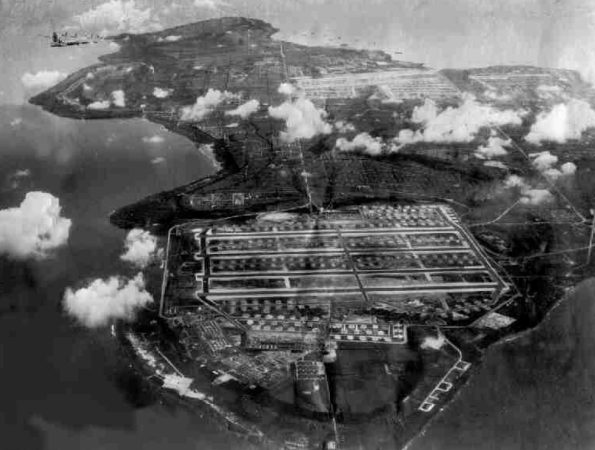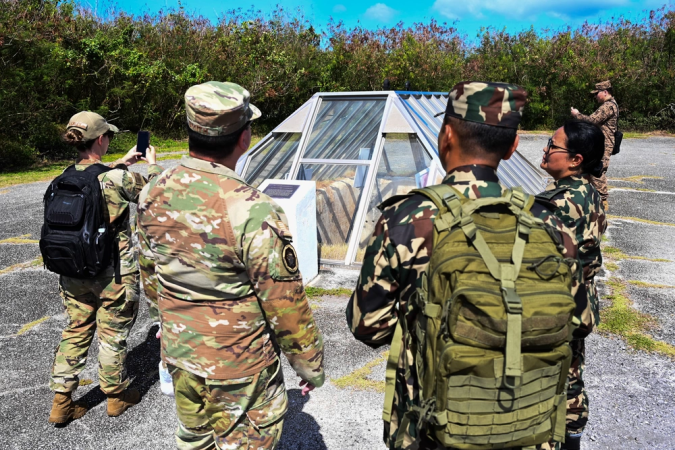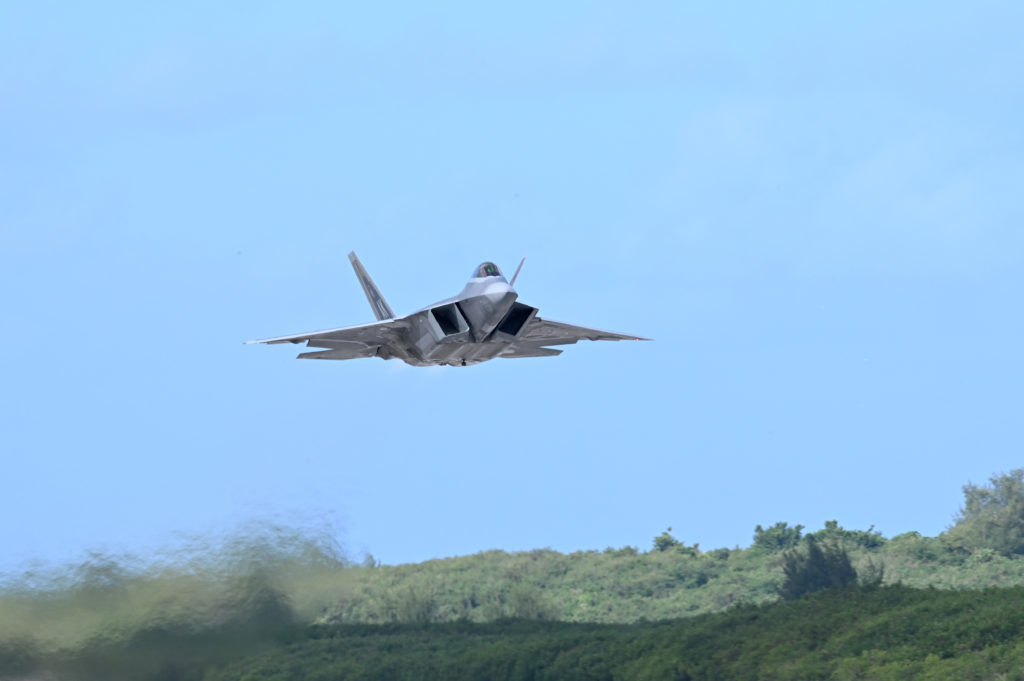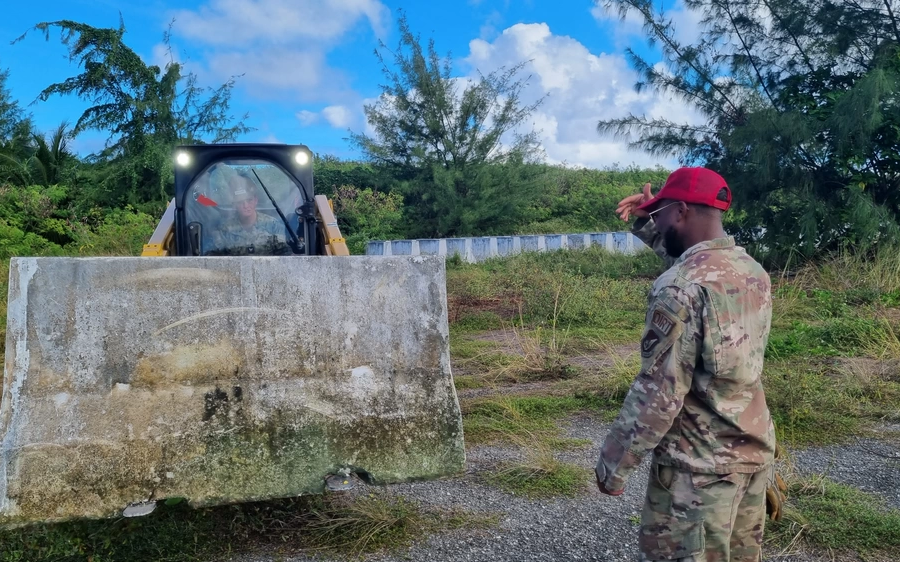Clearing jungle and laying asphalt in tropical heat may not sound like fun to most people, but it’s a way of life for Rapid Engineer Deployable Heavy Operational Repair Squadron Engineers (RED HORSE) Airmen, who have spent the past year or so restoring World War II-era airfields on the Pacific island of Tinian.
“This is a huge scale,” Senior Master Sgt. Zachary Long of the 513th Expeditionary RED HORSE Squadron said in a video about the restoration effort posted to the Air Force Civil Engineers YouTube channel on Oct. 24.
“I mean, we’re talking like 500 acres, this area is, and [the Airmen] have the opportunity to run all the heavy equipment,” he added. “You can’t beat it. This is every Dirt Boy’s dream.”
Dirt Boyz is the term for civil engineer Airmen who get their hands dirty pouring concrete, operating bulldozers, fixing pipes, and all the other work involved in maintaining an air base or building a new one. Few units get more sweaty or dirty than RED HORSE squadrons, which move out fast to build or repair airfields, hangars, and other facilities when the Air Force needs it in a hurry.
Last year, the 820th RED HORSE Squadron from Nellis Air Force Base, Nev., arrived at Tinian to restore the runways at North Field, a complex of ramps, runways, and taxiways at the island’s north end. North Field was where Little Boy, the first nuclear weapon used in warfare, was assembled and loaded onto the B-29 Superfortress Enola Gay before its flight to drop the bomb on Hiroshima on Aug. 6, 1945.

The Enola Gay was just one of hundreds of aircraft that took off and landed there after the U.S. seized it from Japan in August, 1944.
“As soon as the island was seized, the Seabees, the Navy’s construction battalions, began work on the largest airbase of World War II—and in fact the largest airfield in the world at the time,” according to the National Park Service. Eventually 40,000 people worked at the base, which had six 8,500-foot runways: four in North Field and two more farther south at West Field.

From there, B-29s took off to bomb Japan and Southeast Asia, but the airfields were largely abandoned by the U.S. military between 1946 and 2003, when Marines returned to Tinian for a training exercise. Marine aircraft and Guam Air National Guardsmen used a few North Field runways in the 2000s and 2010s, while Seabees and Marine engineers started improving infrastructure on the island at least as early as 2020.
The former West Field became the Tinian International Airport and is still in use to this day: Air Force F-22 fighters landed there for the first time in March 2023. That year, the Air Force went public with its plans to restore North Field, with then-Pacific Air Forces commander Gen. Kenneth Wilsbach telling Nikkei Asia that the area would be transformed into an “extensive” facility. The Air Force received $79 million in its 2024 budget for construction projects on the island.

The return to Tinian is part of a strategy called Agile Combat Employment, where, in a conflict with China, small groups of Airmen would launch and recover aircraft from small, scattered air bases to avoid being targeted by long-range missiles. Tinian is one of several locations across the Pacific where the Air Force may operate in a future conflict.
But preparing those airfields takes work, and that’s where units such as RED HORSE come in. The 823rd RED HORSE Squadron from Hurlburt Field, Fla., spent more than six months restoring and rebuilding North Field, putting up new structures and clearing eight decades of overgrown vegetation, according to an April press release. The 823rd went home in April, but other RED HORSE units and Navy Seabees took up the task, with the goal of restoring over 20 million square feet of degraded World War II pavement. Restoring is easier than building brand-new runways, Airmen explained.
“Building new is not the way to go and it’s very expensive,” Lt. Col. Frank Blaz, former commander of the Guam Air National Guard’s 254th RED HORSE Squadron, said in the Civil Engineers video. “Repairing and rehabilitating what exists is a much better economic solution.”
Sometimes the work involved hacking through the jungle with a machete to find GPS coordinates marking the airfield boundary, Master Sgt. Jody Branson, operations superintendent with the 513th Expeditionary RED HORSE Squadron, told the Wall Street Journal in a recent video.
“This was part of the battle that we fought every day, going through the jungle to mark these points the entire day through the rain, through the humidity and the heat of the day,” he said.

The work paid off: squadron commander Maj. Blake Rothschild told the Journal that the team cleared North Field’s Charlie runway, which was completely covered in vegetation before they arrived.
“Over the last 60 days, what they have opened up is really monumental,” he said. “It’s crazy how fast they’ve done it.”
Completing the mission could take years, but it’s a top priority for Air Force officials, including Chief of Staff Gen. David W. Allvin.
“Our Airmen at Tinian are successfully expanding our Agile Combat Employment options to enhance deterrence, increase flexibility, and, if needed, rapidly generate combat power,” Allvin said after visiting Tinian in April. “They are the pathfinders for advancing our scheme of maneuver in the Indo-Pacific.”

